Why Is My Cat Peeing In the Sink? Reasons and Solution!
Updated: 6 Apr 2024
584
Introduction: Why Cats Urinate in the Sink
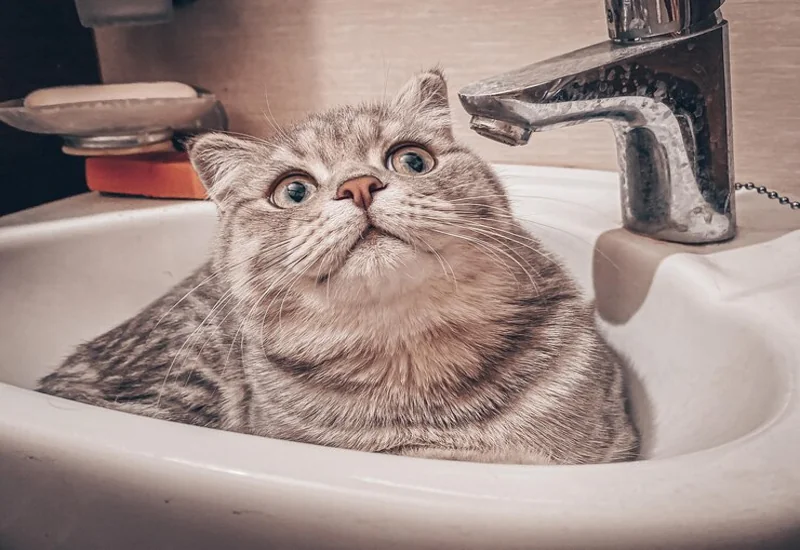
When you enter your bathroom and see your beloved cat urine on the edge of the sink, relieving itself. This sight makes many cat owners shake their heads in confusion. Why would a cat pee in the sink when it has a perfectly good litter box?
“Why is my cat peeing in the sink?” If you’ve ever asked yourself this question, you’re not alone. It’s important to know the reasons for this strange behavior. This is important to fix the problem and maintain a good bond with your cat.
In this article, we look at the possible causes and solutions for this cat behavior.
Understanding Feline Behavior
Cats are creatures of habit. They thrive on routine and predictability. This is especially true when it comes to their elimination behavior. Cats are very meticulous when it comes to their toilet habits and prefer the same place to relieve themselves.
If a cat starts peeing in unusual places such as the sink, this is a clear sign that something is wrong. This behavior can be due to many factors. These include their health issue, stress, and the cleanliness of their environment.
Let’s take a closer look at these factors to answer the question “Why is my cat peeing in the sink?”
Possible Reasons Why Cats Pee in the Sink
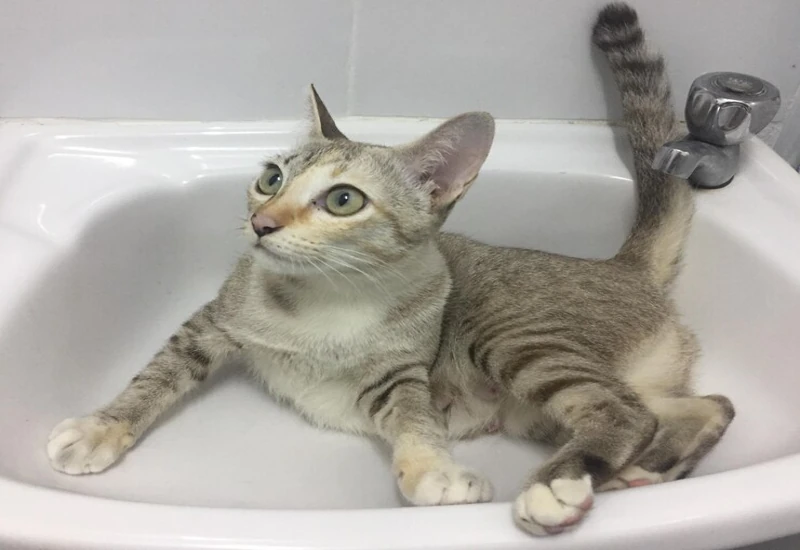
Medical Causes
- Urinary Tract Infections (UTIs): Urinary tract infections are common in cats and can cause discomfort when urinating. If your cat associates this discomfort with the litter tray, it may be peeing in other places, such as the sink. Cats with urinary tract infections need to urinate frequently. They also have problems urinating and bloody urine.
- Kidney Issues: Kidney disease or kidney stones can increase your cat’s urge to urinate. If the cats litter box is not accessible when this urge occurs, your cat may use the sink instead. Kidney problems can also cause other symptoms. These include: increased thirst, weight loss, and reduced appetite.
- Diabetes: Diabetes is a disease that affects the body’s ability to regulate blood sugar levels. One of the main symptoms of cats with diabetes is increased urination. If your cat is peeing more and the litter box is not clean or accessible, he may start using the sink.
Behavioral Causes
- Stress or Anxiety: Cats are sensitive creatures. They can become stressed or anxious as a result of change. This can be a new pet or family member, a move to a new home or even rearranging the furniture. When cats are stressed, they may exhibit unusual behaviors, such as peeing in the sink.
- Territory Marking: Cats are territorial animals and mark their territory with their urine. This behavior is more common in households with many cats. There they compete for resources. If your cat pees in the sink, it could be their way of claiming this space for themselves.
- Litter Box Aversion: Cats can develop an aversion to their litter box for various reasons. The box may be too dirty. It could be in a noisy or high-traffic area. Or your cat may have been frightened when using the litter tray and had a bad experience. In such cases, your cat may look for other places to pee, such as the sink.
Environmental Factors
- Location Preference: Some cats prefer the cool, smooth surface of the sink to the texture of cat litter. This preference could be due to previous experience, comfort, or the cat’s personality.
- Cleanliness of the Litter Box: Cats are clean animals and prefer to do their business in a clean place. If the litter box is dirty, your cat may look for cleaner alternatives, such as the sink.
- Changes in the Household Environment: Any change in your cat’s environment can cause stress and lead to behavioral changes. This includes new furniture, a new pet, or even a new person in the house. If these changes coincide with your cat peeing in the sink, this could be the cause.
Addressing the Issue
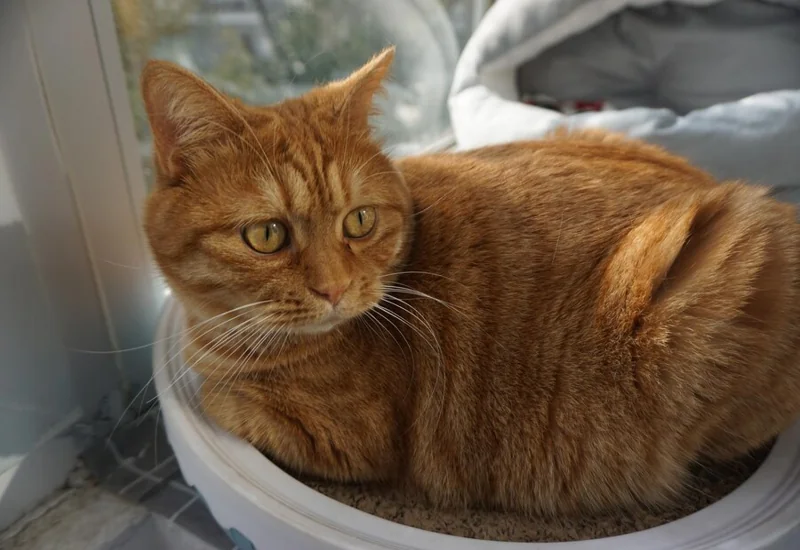
Veterinary Examination
- Importance of Ruling Out Medical Conditions: If your cat starts peeing in the sink, the first step should always be a veterinary examination. Many health conditions can alter elimination behavior. It’s important to rule these out before considering changes in behavior or environment.
- Diagnostic Tests and Examinations: Your veterinarian will likely perform a physical examination. They may also recommend tests such as a urinalysis or blood test. These tests can help identify underlying illnesses that may be causing your cat behavior.
Behavioral Modification
- Creating a Stress-Free Environment: Reducing the stress in your cat’s environment can help solve behavior problems. This can mean providing plenty of hiding places and high perches. You can use pheromone diffusers. Also make sure your cat has a quiet, safe place to retreat to.
- Providing Multiple Litter Boxes: In households with multiple cats, competition for resources can lead to stress and behavioral problems. Multiple litter trays ensure that each cat has its own space. This reduces competition and possible conflicts.
- Using Pheromone Diffusers: Pheromone diffusers release fake cat facial pheromones. Cats associate these pheromones with safety and security. They can help create a calming environment and reduce stress-related behaviors.
Environmental Changes
- Keeping the Sink Area Inaccessible: If you can, keep the bathroom door closed. Or cover the sink with a cover. This will stop your cat from using it as a litter box.
- Ensuring the Litter Box is Clean and Inviting: Cleaning the litter tray and using unscented litter will make it more attractive to your cat. Also, consider where the litter tray is located — cats prefer quiet, low-traffic areas.
- Implementing Positive Reinforcement Techniques: Reward your cat when they use the litter box correctly to encourage good behavior. This can be done with treats, praise, or extra cuddles.
“If you’re also wondering why your cat is peeing on your clothes, check out this helpful article for 15 solutions.”
How Do You Clean Cat Pee Out Of A Sink?
Sure, here’s how you can clean cat pee out of a sink:
- Find the Stain: If the cat urine is fresh, you can clean it more easily. For dried stains, you may need to feel for a sticky stain or use a black light to make the urine glow in the dark.
- Soak Up the Stain: Use paper towels or a cloth towel to soak up as much urine as possible. Avoid rubbing the stain as this can cause it to sink in even deeper.
- Apply a Cleaner: Treat the stained area with a stain remover. You can use a commercially available product or make your solution using vinegar or baking soda. Rinse the sink with the solution, let it sit for a few minutes, then scrub the sink thoroughly and rinse.
- Use an Enzymatic Cleaner: Spray the entire sink with an enzymatic cleaner. This type of cleaner will break down the proteins in the cat urine, remove the stain, and neutralize the odor. Let the cleaner sit in your sink for a few minutes and then rinse it off.
How to Stop a Cat from Peeing in the Sink
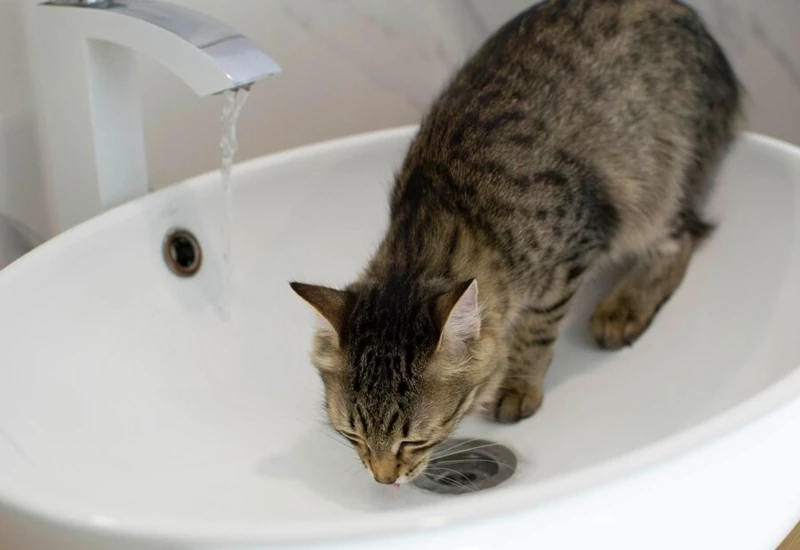
The key to stopping your cat from peeing in the sink is to address the cause of the behavior. This can be medical treatment, behavior modification, or a change in environment. Patience and consistency are key in this process.
Punishing your cat for peeing outside the box is unlikely to solve the problem. It may even make the behavior worse.
Preventive Measures and Long-Term Solutions
Prevention is always better than cure. Regular veterinary examinations can help to identify medical problems at an early stage. This prevents them from leading to behavioral problems.
Regular cleaning of the litter tray helps. So does observing changes in behavior. And creating a cat-friendly home. These things also prevent peeing outside the box.
Your cat behavior is a form of communication. The first step is to listen to your cat. This will help you solve problems and maintain a happy, healthy relationship.
Training Tips to Prevent Cats from Peeing in the Sink
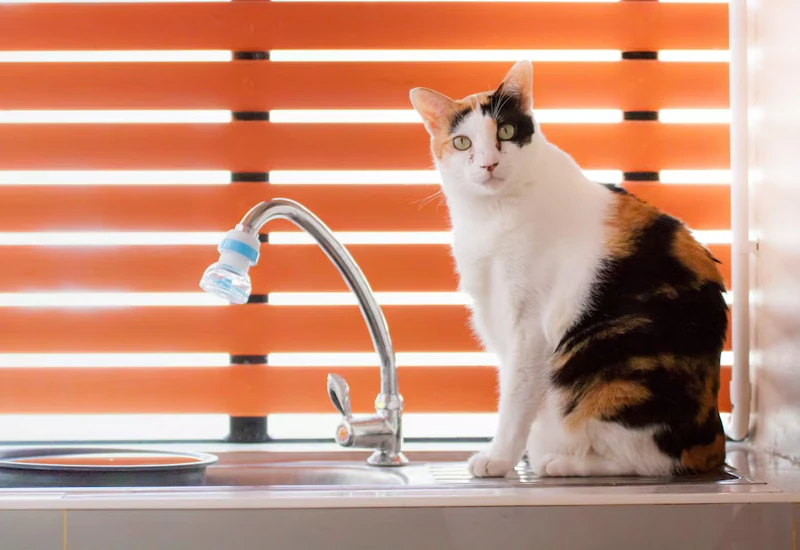
To teach your cat to use the litter tray consistently, you need patience. It also needs positive reinforcement. And sometimes it also takes a little trial and error.
Experiment with different types of litter, litter tray types, and locations until you find out what your cat prefers.
Conclusion
Cats peeing in the wrong place can be frustrating. But with understanding, patience, and the right approach, you can solve the problem.
Your cat isn’t peeing in the sink to annoy you – the cat’s trying to tell you something. It’s up to us cat owners to listen to her and respond in a way that promotes her health and happiness.
If you don’t know How Long Can a Cat Go Without Peeing? this guide will provide comprehensive insights.
Always consult a professional if you are unsure or if the problem persists. Here’s to a happy, healthy life with your feline friend!
I hope this guide on “Why Is My Cat Peeing In the Sink” helps you. If you still have questions, please read it again carefully.
Why is my cat peeing in the sink at night?
Your cat may pee in the sink at night because the litter tray is inaccessible. It is not clean, because it has no privacy, or because it is ill.
Why does my cat keep going in the sink?
Your cat may go to the sink for many reasons. Maybe she likes the cool, smooth surface. Maybe she has litter box problems or is sick.
Why male cat and female cat peeing on sink?
Your male cat and female cat might be peeing in the sink due to a medical issue, stress, or dissatisfaction with their litter box. It’s important to consult with a vet to rule out any health problems.
Please Write Your Comments